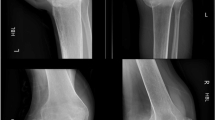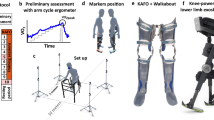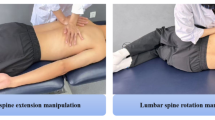Abstract
Introduction
Patients with spinal cord injury (SCI) and concomitant lower limb fractures are a challenge to rehabilitate. Conventionally, postural orientation is an important milestone in the rehabilitative process. We propose an alternative strategy in achieving goals in individuals with an SCI with concomitant injuries that preclude weight bearing below the knee.
Case presentation
A 16-year-old girl sustained a burst fracture of L1 in conjunction with bilateral ankle fractures. During rehabilitation, the calcaneal fracture on the left and tibial plafond fracture on the right prevented her progression in conventional rehabilitation. An alternative strategy “K-ing” (Kneel Standing/Kneel Walking) was adopted to facilitate truncal activation without loading the ankle joints. This was found to be helpful in obtaining upright posture stability without hampering her recovery of associated ankle injuries.
Discussion
“K-ing” strategy can be useful and presents a simple alternative in the presence of associated ankle injuries. It also avoids complications associated with bedrest when there is delay in initiation of ambulation.
Similar content being viewed by others
Log in or create a free account to read this content
Gain free access to this article, as well as selected content from this journal and more on nature.com
or
References
Nas K, Yazmalar L, Sah V, Aydin A, Ones K. Rehabilitation of spinal cord injuries. World J Orthop. 2015;6:8–16.
Ragnarsson KT. Medical rehabilitation of people with spinal cord injury during 40 years of academic physiatric practice. Am J Phys Med Rehabil. 2012;91:231–42.
Carbone LD, Chin AS, Burns SP, Svircev JN, Hoenig H, Heggeness M, et al. Morbidity following lower extremity fractures in men with spinal cord injury. Osteoporos Int. 2013;24:2261–7.
Frotzler A, Cheikh-Sarraf B, Pourtehrani M, Krebs J, Lippuner K. Long-bone fractures in persons with spinal cord injury. Spinal Cord. 2015;53:701–4.
Walters JL, Gangopadhyay P, Malay DS. Association of calcaneal and spinal fractures. J Foot Ankle Surg. 2014;53:279–81.
Harkema SJ, Hillyer J, Schmidt-Read M, Ardolino E, Sisto SA, Behrman AL. Locomotor training: as a treatment of spinal cord injury and in the progression of neurologic rehabilitation. Arch Phys Med Rehabil. 2012;93:1588–97.
Dietz V, Harkema SJ. Locomotor activity in spinal cord-injured persons. J Appl Physiol. 2004;96:1954–60.
Krajacic A, Ghosh M, Puentes R, Pearse DD, Fouad K. Advantages of delaying the onset of rehabilitative reaching training in rats with incomplete spinal cord injury. Eur J Neurosci. 2009;29:641–51.
Wrigley PJ, Gustin SM, Macey PM, Nash PG, Gandevia SC, Macefield VG, et al. Anatomical changes in human motor cortex and motor pathways following complete thoracic spinal cord injury. Cereb Cortex. 2009;19:224–32.
Roberts TT, Leonard GR, Cepela DJ. Classifications in brief: American Spinal Injury Association (ASIA) impairment scale. Clin Orthop Relat Res. 2017;475:1499–504.
de Freitas GR, Santo C, de Machado-Pereira N, Bobinski F, Dos Santos ARS, Ilha J. Early cyclical neuromuscular electrical stimulation improves strength and trophism by akt pathway signaling in partially paralyzed biceps muscle after spinal cord injury in rats. Phys Ther. 2018;98:172–81.
Fehlings MG, Tetreault LA, Aarabi B, Anderson P, Arnold PM, Brodke DS, et al. A clinical practice guideline for the management of patients with acute spinal cord injury: recommendations on the type and timing of rehabilitation. Global Spine J. 2017;7(3 Suppl):231s–8s.
Eng JJ, Teasell R, Miller WC, Wolfe DL, Townson AF, Aubut JA, et al. Spinal cord injury rehabilitation evidence: methods of the SCIRE systematic review. Top Spinal Cord Inj Rehabil. 2007;13:1–10.
Yang Y, Zhao H, Zhou J, Yu G. Treatment of displaced intraarticular calcaneal fractures with or without bone grafts: a systematic review of the literature. Indian J Orthop. 2012;46:130–7.
Marsh JL, McKinley T, Dirschl D, Pick A, Haft G, Anderson DD, et al. The sequential recovery of health status after tibial plafond fractures. J Orthop Trauma. 2010;24:499–504.
Menon N, Gupta A, Khanna M, Taly AB. Ambulation following spinal cord injury and its correlates. Ann Indian Acad Neurol. 2015;18:167–70.
Driver S, Warren AM, Reynolds M, Agtarap S, Hamilton R, Trost Z, et al. Identifying predictors of resilience at inpatient and 3-month post-spinal cord injury. J Spinal Cord Med. 2016;39:77–84.
Drigotaite N, Krisciunas A. [Complications after spinal cord injuries and their influence on the effectiveness of rehabilitation]. Medicina. 2006;42:877–80.
Madsen UR, Hommel A, Berthelsen CB, Baath C. Systematic review describing the effect of early mobilisation after dysvascular major lower limb amputations. J Clin Nurs. 2017;26:3286–97.
Harvey L. Management of spinal cord injuries. London: Elsevier; 2008.
Gallagher S. Trunk extension strength and muscle activity in standing and kneeling postures. Spine. 1997;22:1864–72.
Ulbrich J, Raheja A, Alexander NB. Body positions used by healthy and frail older adults to rise from the floor. J Am Geriatr Soc. 2000;48:1626–32.
Edgerton VR, Tillakaratne NJ, Bigbee AJ, de Leon RD, Roy RR. Plasticity of the spinal neural circuitry after injury. Annu Rev Neurosci. 2004;27:145–67.
Dietz VG. Heiner Sell memorial lecture: neuronal plasticity after spinal cord injury: significance for present and future treatments. J Spinal Cord Med. 2006;29:481–8.
Roy RR, Harkema SJ, Edgerton VR. Basic concepts of activity-based interventions for improved recovery of motor function after spinal cord injury. Arch Phys Med Rehabil. 2012;93:1487–97.
Behrman AL, Bowden MG, Nair PM. Neuroplasticity after spinal cord injury and training: an emerging paradigm shift in rehabilitation and walking recovery. Phys Ther. 2006;86:1406–25.
Truchon C, Fallah N, Santos A, Vachon J, Noonan VK, Cheng CL. Impact of therapy on recovery during rehabilitation in patients with traumatic spinal cord injury. J Neurotrauma. 2017;34:2901–9.
Author information
Authors and Affiliations
Corresponding author
Ethics declarations
Conflict of interest
The authors declare that they have no conflict of interest.
Additional information
Publisher’s note: Springer Nature remains neutral with regard to jurisdictional claims in published maps and institutional affiliations.
Rights and permissions
About this article
Cite this article
Jagadevan, M., Mohanakrishnan, B., Murugesan, S. et al. Progression to ambulation following lower limb fractures in an individual with a spinal cord injury: a case report. Spinal Cord Ser Cases 5, 26 (2019). https://doi.org/10.1038/s41394-019-0171-2
Received:
Revised:
Accepted:
Published:
DOI: https://doi.org/10.1038/s41394-019-0171-2



